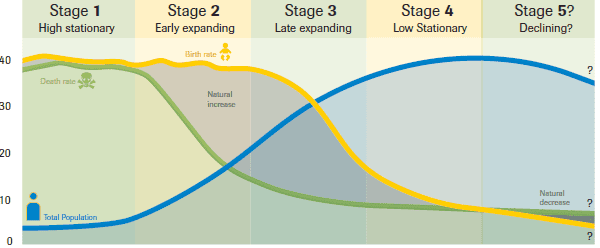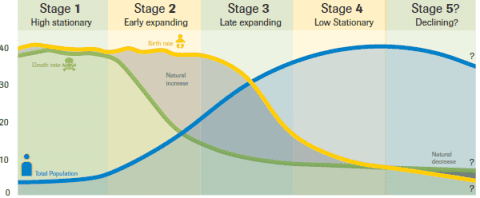Dentify and Explain the Different Stages of Demographic Transition
The Demographic Transition Model DMT shows how birth and death rates change as country goes through different stages of development. The decline in birth rates and death rates is likely due to strong economies highly educated citizens ample health care systems the migration of people from rural cities and expanded employment opportunities for women.

What Is The Demographic Transition Model Population Education
Rate of Natural Increase shoots up growth rate increases throughout this stage.

. Dolan Demographic transition refers to a population cycle that begins with a fall in the death rate continues with a phase of rapid population. Must mention Stage 4 fourth final or low stationary stage AND elaborate briefly about its. Stage 2 with a high birth rate and a youthful population and is a developing country.
Summarize the four stages of the demographic transition model DTM Define the science of futuring and identify a potential fifth stage. The first stage is characterised by high birth rate high death. Population growth was kept low by Malthusian preventative late age at marriage and.
In this stage the birth rates are very high but the life expectancy is increased so the population grows rapidly. High Birth Rate of High Death Rate. Most developed countries are in stage 3 or 4 of the model.
High birth rates over 30 but death rates decline to about 20 3. In this stage the birth rates are very high but also the life expectancy is very low thus the growth of the population is slow. As per the theory of demographic transition a country is subjected to both high birth and death rates at the first.
Ad Over 27000 video lessons and other resources youre guaranteed to find what you need. How does this transition model apply or not apply to the global south developing world. It is a developed country and there is a possible Stage 5.
Growth not from increase in birth but from decline in deaths. Up to 24 cash back In this stage both birth rates and death rates are both low stabilizing total population growth. Use a graph to illustrate how diffusion occurs over time.
Identify demographic factors that influence the stage of development for Country A. In the traditional societies due to the lesser population the. Identify and explain the three types of diffusion.
Even though crude birth rate. Rapidly Falling Death Rate High Birth Rate. So the population remains low and stable.
The second stage is. Explain comprehensively how each demographic transition model stages shift in terms of the birth and. Countries in stage 5 of the DTM have lower birth rates than death rates which means the population total is declining and the population structure is aging.
With the gradual attainment of economic development the living condition of people started to improve due to. Stage II is characterised by high and stationary birth rate rapidly declining death rate and very rapid increase in population. Must mention Stage 2 second or early expanding stage AND elaborate briefly about its characteristics such as high birth rate falling death rate youthful population developing country.
In the words of EG. Pre-transition Characterised by high birth rates and high fluctuating death rates. An example is Japan where around 28 of the total population is aged over 65.
The majority of developing countries have reached stage 2 or stage 3. Stage I is characterised by high birth rate death rate and low rate of population growth. Places in the Amazon Brazil and rural communities of Bangladesh would be at this stage.
Most elderly people are retired and no longer paying income tax therefore the. Introduction to the Theory of Demographic Transition. There are four stages to the classical demographic transition model.
The transition from high birth and death rates to low rates can be divided into stages. Country A It is not acceptable to suggest Stages 1 or 3 for Country A. The model has five stages.
Demographic history developed in 1929 by the American demographer Warren Thompson. Define the demographic transition model. Thompson observed changes or transitions in birth and death rates in industrialized societies over the previous 200 years.
The theory of demographic transition or of population stages or of population cycle has many versions. The demographic transition theory is characterized by conspicuous transition stages. It has been propounded by WS.
1 What are the four stages of the demographic transition. The population pyramids above represent two countries at different stages of the demographic transition and economic development. Stage 4 with a low birth rate and low death rate with an aging population.
At stage 1 the birth and death rates are both high. Stage III is characterised by a falling birth rate low and stationary death rate and rapidly rising population. This is post 3 of 6 in a series about the Demographic Transition Model a fundamental concept in population education which is covered in Social Studies courses most notably AP Human Geography.
4 Stages of Demographic Transition Theory Explained. Stage 2 of the Demographic Transition Model DTM is characterized by a rapid decrease in a countrys death rate while the birth rate remains high. Identify demographic factors that influence the stage of development for Country B.
They explain the theory in three stages. Stage 2 - Early transition. Explanation of the Theory of Demographic Transition 3.
Stage 1 - Pre-transition. 4 Main Stages of Demographic Transition Economic Development 1. 3 Explain the different aspects of both the slow world and the fast world.
Stage 3 - Late transition.

What Is The Demographic Transition Model Demographic Transition Human Geography Ap Human Geography

Stage 1 Of The Demographic Transition Model Population Education

Gcse Aqa 9 1 The Demographic Transition Model Carousel Activity Teaching Resources Demographic Transition Aqa Gcse Geography Revision
Comments
Post a Comment